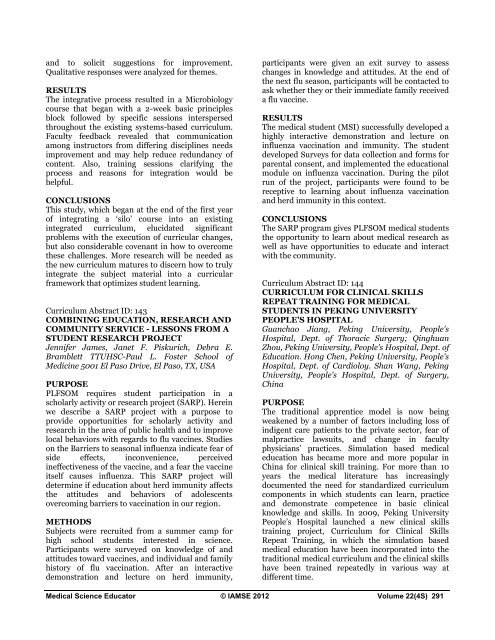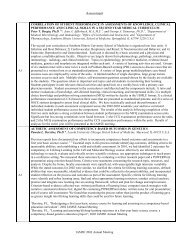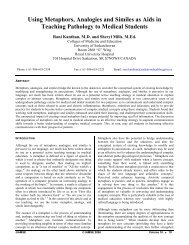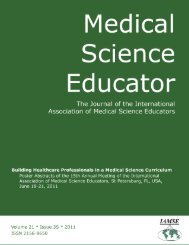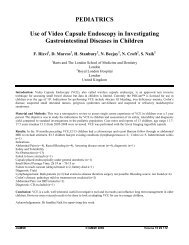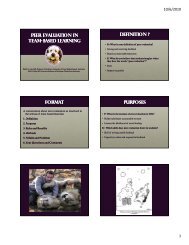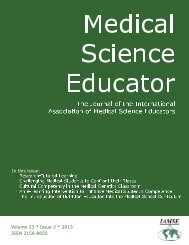Click here to view complete journal in pdf-format - IAMSE
Click here to view complete journal in pdf-format - IAMSE
Click here to view complete journal in pdf-format - IAMSE
Create successful ePaper yourself
Turn your PDF publications into a flip-book with our unique Google optimized e-Paper software.
and <strong>to</strong> solicit suggestions for improvement.<br />
Qualitative responses were analyzed for themes.<br />
RESULTS<br />
The <strong>in</strong>tegrative process resulted <strong>in</strong> a Microbiology<br />
course that began with a 2-week basic pr<strong>in</strong>ciples<br />
block followed by specific sessions <strong>in</strong>terspersed<br />
throughout the exist<strong>in</strong>g systems-based curriculum.<br />
Faculty feedback revealed that communication<br />
among <strong>in</strong>struc<strong>to</strong>rs from differ<strong>in</strong>g discipl<strong>in</strong>es needs<br />
improvement and may help reduce redundancy of<br />
content. Also, tra<strong>in</strong><strong>in</strong>g sessions clarify<strong>in</strong>g the<br />
process and reasons for <strong>in</strong>tegration would be<br />
helpful.<br />
CONCLUSIONS<br />
This study, which began at the end of the first year<br />
of <strong>in</strong>tegrat<strong>in</strong>g a ‘silo’ course <strong>in</strong><strong>to</strong> an exist<strong>in</strong>g<br />
<strong>in</strong>tegrated curriculum, elucidated significant<br />
problems with the execution of curricular changes,<br />
but also considerable covenant <strong>in</strong> how <strong>to</strong> overcome<br />
these challenges. More research will be needed as<br />
the new curriculum matures <strong>to</strong> discern how <strong>to</strong> truly<br />
<strong>in</strong>tegrate the subject material <strong>in</strong><strong>to</strong> a curricular<br />
framework that optimizes student learn<strong>in</strong>g.<br />
Curriculum Abstract ID: 143<br />
COMBINING EDUCATION, RESEARCH AND<br />
COMMUNITY SERVICE - LESSONS FROM A<br />
STUDENT RESEARCH PROJECT<br />
Jennifer James, Janet F. Piskurich, Debra E.<br />
Bramblett TTUHSC-Paul L. Foster School of<br />
Medic<strong>in</strong>e 5001 El Paso Drive, El Paso, TX, USA<br />
PURPOSE<br />
PLFSOM requires student participation <strong>in</strong> a<br />
scholarly activity or research project (SARP). Here<strong>in</strong><br />
we describe a SARP project with a purpose <strong>to</strong><br />
provide opportunities for scholarly activity and<br />
research <strong>in</strong> the area of public health and <strong>to</strong> improve<br />
local behaviors with regards <strong>to</strong> flu vacc<strong>in</strong>es. Studies<br />
on the Barriers <strong>to</strong> seasonal <strong>in</strong>fluenza <strong>in</strong>dicate fear of<br />
side effects, <strong>in</strong>convenience, perceived<br />
<strong>in</strong>effectiveness of the vacc<strong>in</strong>e, and a fear the vacc<strong>in</strong>e<br />
itself causes <strong>in</strong>fluenza. This SARP project will<br />
determ<strong>in</strong>e if education about herd immunity affects<br />
the attitudes and behaviors of adolescents<br />
overcom<strong>in</strong>g barriers <strong>to</strong> vacc<strong>in</strong>ation <strong>in</strong> our region.<br />
METHODS<br />
Subjects were recruited from a summer camp for<br />
high school students <strong>in</strong>terested <strong>in</strong> science.<br />
Participants were surveyed on knowledge of and<br />
attitudes <strong>to</strong>ward vacc<strong>in</strong>es, and <strong>in</strong>dividual and family<br />
his<strong>to</strong>ry of flu vacc<strong>in</strong>ation. After an <strong>in</strong>teractive<br />
demonstration and lecture on herd immunity,<br />
participants were given an exit survey <strong>to</strong> assess<br />
changes <strong>in</strong> knowledge and attitudes. At the end of<br />
the next flu season, participants will be contacted <strong>to</strong><br />
ask whether they or their immediate family received<br />
a flu vacc<strong>in</strong>e.<br />
RESULTS<br />
The medical student (MSI) successfully developed a<br />
highly <strong>in</strong>teractive demonstration and lecture on<br />
<strong>in</strong>fluenza vacc<strong>in</strong>ation and immunity. The student<br />
developed Surveys for data collection and forms for<br />
parental consent, and implemented the educational<br />
module on <strong>in</strong>fluenza vacc<strong>in</strong>ation. Dur<strong>in</strong>g the pilot<br />
run of the project, participants were found <strong>to</strong> be<br />
receptive <strong>to</strong> learn<strong>in</strong>g about <strong>in</strong>fluenza vacc<strong>in</strong>ation<br />
and herd immunity <strong>in</strong> this context.<br />
CONCLUSIONS<br />
The SARP program gives PLFSOM medical students<br />
the opportunity <strong>to</strong> learn about medical research as<br />
well as have opportunities <strong>to</strong> educate and <strong>in</strong>teract<br />
with the community.<br />
Curriculum Abstract ID: 144<br />
CURRICULUM FOR CLINICAL SKILLS<br />
REPEAT TRAINING FOR MEDICAL<br />
STUDENTS IN PEKING UNIVERSITY<br />
PEOPLE'S HOSPITAL<br />
Guanchao Jiang, Pek<strong>in</strong>g University, People's<br />
Hospital, Dept. of Thoracic Surgery; Q<strong>in</strong>ghuan<br />
Zhou, Pek<strong>in</strong>g University, People's Hospital, Dept. of<br />
Education. Hong Chen, Pek<strong>in</strong>g University, People's<br />
Hospital, Dept. of Cardioloy. Shan Wang, Pek<strong>in</strong>g<br />
University, People's Hospital, Dept. of Surgery,<br />
Ch<strong>in</strong>a<br />
PURPOSE<br />
The traditional apprentice model is now be<strong>in</strong>g<br />
weakened by a number of fac<strong>to</strong>rs <strong>in</strong>clud<strong>in</strong>g loss of<br />
<strong>in</strong>digent care patients <strong>to</strong> the private sec<strong>to</strong>r, fear of<br />
malpractice lawsuits, and change <strong>in</strong> faculty<br />
physicians’ practices. Simulation based medical<br />
education has became more and more popular <strong>in</strong><br />
Ch<strong>in</strong>a for cl<strong>in</strong>ical skill tra<strong>in</strong><strong>in</strong>g. For more than 10<br />
years the medical literature has <strong>in</strong>creas<strong>in</strong>gly<br />
documented the need for standardized curriculum<br />
components <strong>in</strong> which students can learn, practice<br />
and demonstrate competence <strong>in</strong> basic cl<strong>in</strong>ical<br />
knowledge and skills. In 2009, Pek<strong>in</strong>g University<br />
People’s Hospital launched a new cl<strong>in</strong>ical skills<br />
tra<strong>in</strong><strong>in</strong>g project, Curriculum for Cl<strong>in</strong>ical Skills<br />
Repeat Tra<strong>in</strong><strong>in</strong>g, <strong>in</strong> which the simulation based<br />
medical education have been <strong>in</strong>corporated <strong>in</strong><strong>to</strong> the<br />
traditional medical curriculum and the cl<strong>in</strong>ical skills<br />
have been tra<strong>in</strong>ed repeatedly <strong>in</strong> various way at<br />
different time.<br />
Medical Science Educa<strong>to</strong>r © <strong>IAMSE</strong> 2012 Volume 22(4S) 291


